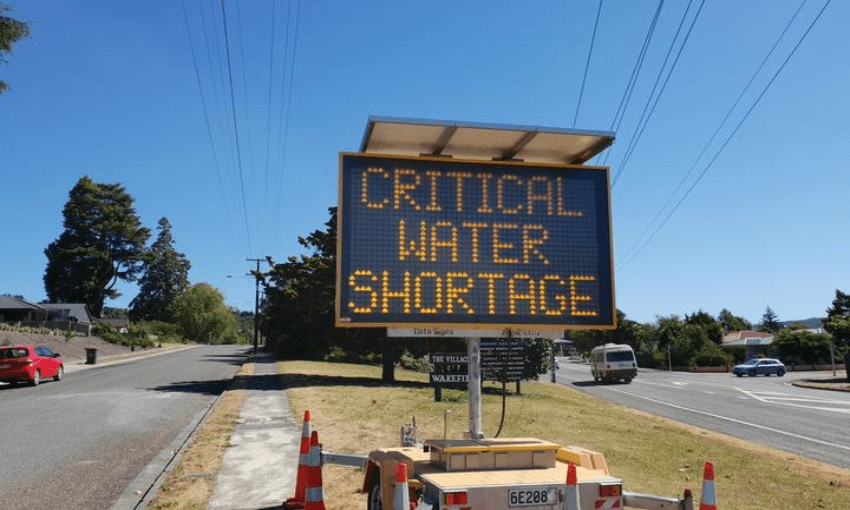Increasingly large swathes of the country are getting bone dry, and it’s starting to cause serious problems. In today’s cheat sheet, Alex Braae looks into how bad the North Island drought is getting.
What’s all this then?
If you live in Auckland or further north, have you noticed how it hasn’t really rained all that much this year? Like, at all? In fact, over the entire month of January, only one day saw any decent rain in Auckland. In Northland it’s basically the same, and it also follows an unusually dry winter. And to the south, there are large areas of the country that aren’t seeing nearly enough rain either. Marlborough? Dry. Hawke’s Bay? Dry. Wairarapa? Dry. The East Cape? Real dry.
To see what the current rainfall levels look like in context, Niwa’s NZ Drought Monitor has been giving daily updates of conditions, and compiled them into this handy map:
There’s a lot of red on that map.
It’s an extremely large amount of red. And to underline how serious it is, more than half of New Zealand’s population lives north of Taupō, and most of that segment lives in areas currently rated ‘drought’ or worse. It’s not just a North Island problem either, with the heavily populated Canterbury region showing some serious heat. Even Wellington, which has had a relatively dreadful summer for sun-lovers, is currently rated as dry.
What about the bits down in Southland and up the West Coast?
The good news is that they’re not at risk of being in drought. The bad news is that it’s because the area has been hit with catastrophically high levels of rain, which caused severe disruption and flooding.
Is the fire risk higher at the moment?
Much higher. An example is currently underway in the Rangitikei district, near Bulls, where a scrub fire has been burning since yesterday. Around 80 hectares were burnt in the fire (slightly bigger than the equivalent of 80 rugby fields) and the smoke could be seen as far away as Woodville, a bit over 50kms away. That of course doesn’t sound like much in comparison to the Australian bushfires this summer, but this is a smaller country with much less to burn, and it’s not the only one we’ve seen this year. There have also been blazes near Napier, around the Whanganui River, up in Northland, and around Canterbury. In the case of that last one, the conditions are reportedly very similar to those before the terrible Port Hills fires of 2017.
If the rural landscape is very dry, does that mean this is bad for farming?
That’s also being very hard hit, with many having to send stock to the meatworks early. The lack of grass means less feed is available now, and also means less will be able to be baled up for winter. Parts of the Waikato that heavily depend on dairy farming are also likely to see much less pasture growth than what they’d typically get, meaning less milk comes out of each cow.
And how about people in cities and towns?
Various water restrictions are now in place all over the country, ranging from people being asked to be a bit conscientious about how long they’re showering or watering the garden for, to the extreme end of schools possibly needing to close until the rain returns.
In Auckland, people are being asked to cut their water use voluntarily at the moment, with a record level of demand in place. City officials say there are currently no plans to implement restrictions, but it does rather feel like those sorts of decisions could become more pressing if the sun-heavy forecast is correct – right now Auckland is expected to get a little bit of rain in about a week. And out in the more distant western fringes of the city, where many residents are on tanks, the situation has become a “nightmare” for businesses who truck water around, with there simply being not enough logistical capability to get it to everyone who needs it.
By contrast, the Northland towns of Kaikohe and Dargaville are in absolute crisis. In the case of Kaikohe, the town may even simply run out of water altogether. As in, there just won’t be anything coming out of the taps. If that happens, school Boards of Trustees will have to decide whether they can safely stay open. Kaitaia is also undergoing their driest year ever, or at least since records began in 1949.
Is this climate change?
To a degree, absolutely yes. To what degree, it’s harder to say. But we do have weather pattern forecasts that indicate that typically dry areas of the country will be on average much drier in the coming years. And the increased temperatures we’ve been seeing for a while now are also having an impact. As climate scientist James Renwick put it last month, “it has now been 35 months since New Zealand had a month with below-average temperatures”. That should worry anyone who enjoys a regular shower and a tall glasses of water.
The final word:
In difficult times like these, it can help to remember the wisdom of earlier generations. So for everyone who’s Grandma ever told them “if it’s yellow, let it mellow,” now might be time to start thinking about adopting that policy.

